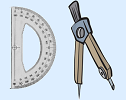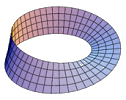Arithmetic » Scientific notation
Contents
Scientific notationSignificand and exponent
Standard form
Calculations with the scientific notation
On the calculator
Engineering notation
On the calculator
Scientific notation
The scientific notation is also known as the scientific form.
It can be difficult or tiresome to work with large numbers
For example, the zeros in 231 000 000 000 metres can be hard to work with.
As you know a number will change when you multiply it with 10. In mathematics and other exact sciences this is used. The nice thing of multiplying with 10 is that only the decimal dot is moving its position in the number.
When working with such a number it is handier to use the scientific notation.
That means that you do not write all the zeros, but you write: ... × 10....
In words: ... times ten to the power of ...
Writing the number used above in the scientific notation goes like this:
231 000 000 000 = 2.31 × 1011 = 2.31 times 10 to the power of 11.
In other words: 231 000 000 000 is equal to 2.31 that you have to multiply 11 times with 10.
Easiest to remember: to get to 2.31 from 231 000 000 000, you have to move the decimal dot 11 places.
Examples
3500 = 3.5 × 103
489 000 = 4.89 × 105
12 = 1.2 × 10
The scientific notation also works with very small numbers, e.g. 0.000 000 42.
In that case you do not multiply with 10, but divide by 10.
We will not get ... : 10... , but we will write: ... × 10–....
The exponent is negative. The number behind the negative sign is the number of places the decimal dot moves.
So: 0.000 000 42 = 4.2 × 10–7.
Examples
0.35 = 3.5 × 10–1
0.004 89 = 4.89 × 10–3
0.012 = 1.2 × 10–2
Significand and exponent
The scientific notation is always of the format s × 10n. The s is called the significand and the n is called the exponent.
Standard form
Usually the significand will be between 1 and 9.999999... . This form of the scientific notation is called the standard form or the normalized scientific notation.
The significand does not have to be a number between 1 and 9.999999... .
The bold numbers below are in the standard form.
32 000 = 3200 × 101 = 320 × 102 = 32 × 103 = 3.2 × 104 = 0.32 × 105
0.000 41 = 0.41 × 10–3 = 4.1 × 10–4 = 41 × 10–5
Are you still in school?
Unless otherwise told, always use the standard form of the scientific notation!
Calculations with the scientific notation
When calculating with numbers in the scientific notation it is important to take the following things into account:
- The calculation order
- Significant digits (with physics and chemistry, most often not with maths)
Example
The distance between the Sun and Earth is approximately 1.5 × 108 km.
The speed of light is about 2.998 × 108 m/s.
Calculate how long it takes sunlight to travel to Earth.
Answer
1.5 × 108 km = 1.5 × 1011 m
Sunlight takes 1.5 × 10112.998 × 108 = 5.003 × 102 seconds to travel to Earth.
If you have to take significant digits into account, you have to round off to two significant digits as the given value with the smallest accuracy has two significant digits. Then you will also get:
5.003 × 102 seconds ≈ 5.0 × 102 seconds
WATCH OUT!
If you write the calculation with a regular division symbol or key it in on your calculator with the regular division key, you HAVE TO write the number you divide with (divisor) between brackets because of the calculation order. For clarity, you can also write every scientific number between brackets. In that case you will get:
(1.5 × 1011) : (2.998 × 108) = 5.003 × 102 seconds
On the calculator
As explained above you have to watch out for brackets when using the scientific notation on a calculator.
On a lot of calculators you can find a button with EXP, ⋿⋿ or ×10x.
With this button you can quickly key in a number in the scientific notation.
1.5 × 1011 is filled in by keying in 1.5 EXP 11 or 1.5 ⋿⋿ 11.
The display will say 1.5⋿11.
When you have the ×10x key, the display will say 1.5×1011.
Working with this button goes faster and the calculator also sees it as a one number, so it is not necessary to key in brackets around the number. In you calculation on paper, you still write them down of course!
Some calculators can be set to give every answer in the (normalized) scientific notation. In most cases this option can be found under the button with MODE or SETUP. Look for Sci or SCI. Norm or NORMAL is almost always next to it. The calculator will then ask at how many significant digits you want the answer rounded off. When you choose for example 3 here, you will get two decimals as the calculator is also using the standard form.
Choose Norm or NORMAL when you want your calculator in the normal setting. If it asks you then 1 or 2, choose option 2.
Engineering notation
A variant of the scientific notation is the engineering notation or engineering form.
In this notation the exponent is always divisible by three.
Therefore, the significand will lie between 1 and 999.999999... .
Why is this handy?
Let's say you have a distance of 1.12 × 105 metres. You cannot quickly see how many kilometres this is. If the number is written in the engineering notation you would get 112 × 103 meter and you can immediately see this is 112 km.
Numbers in the engineering notation can be quickly converted to another SI-prefix.
Examples
28 × 103 g = 28 kg
7 × 10–3 m = 7 mm
200 × 106 W = 200 MW
1 m = 1 × 103 mm
312 km2 = 312 × 106 m2
42 m3 = 42 × 109 mm3
On the calculator
Some calculators can be set to give every result in the engineering notation. This option is called Eng or ENG. Choose Norm or NORMAL when you want your calculator in the normal setting.











